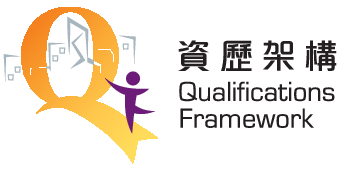Please click the “Qualifications Search” button on the Main page and use one or more search criterion(a) (e.g. Title of Learning Programme) to search for the programme(s).
Qualifications registered in the Qualifications Register are all QF-recognised and they have been quality assured by the Hong Kong Council for Accreditation of Academic and Vocational Qualifications or a self-accrediting operator.
Please check the Qualifications Register (QR) Registration Number of the qualification provided by the operator against the record in the QR. QR Registration Number is a single, unique set of code assigned for every qualification listed on the QR.
If no QR Registration Number is provided, you may click the “Qualifications Search” button on the Main page and use one or more search criterion(a) (e.g. Title of Learning Programme) to search for the programme(s).
Registration Validity Period (RVP) is the period a qualification is registered in the Qualifications Register (QR). Learners should commence the study of the learning programme for a qualification listed on the QR during its RVP, such that the qualification so acquired will be recognised under the Qualifications Framework.
The three types of Registration Status are 1) Current, 2) Prospective and 3) Archived. The definition for each status type is:
|
Current: |
The Registration Validity Period (RVP) of the qualification is valid for learners to commence his/her study of the learning programme for that qualification. |
|
Prospective: |
The RVP of the qualification in the QR is in the future and has not yet started for learners to commence his/her study of the learning programme for that qualification. |
|
Archived: |
The RVP of the qualification in the QR has come to an end and the registration has not been renewed. |
Important Note: If a learner commences his / her study of a learning programme for a qualification on the QR on a date that the Registration Status is “Archived”, the qualification so acquired will NOT be recognised under the Qualifications Framework.
The three types of Registration Status are illustrated in the diagram below:
These learning programmes may not be quality-assured and are not recognised under the Qualifications Framework. It is up to individual learners to decide whether they wish to enroll in these programmes.
There is no provision for retrospective recognition of qualifications granted before the official launch of QF on 5 May 2008 which signifies the full commencement of the Accreditation of Academic and Vocational Qualifications Ordinance (Cap. 592).
The RVP represents the period a qualification is registered on the Qualifications Register. So long as a learner commences the study of the learning programme for a qualification on the QR on a date during its RVP, the recognition of that qualification under the Qualifications Framework shall remain even after the RVP has expired.
You may approach the relevant professional bodies to ascertain whether the qualification you possess is recognised by the body(ies).
It is because the operator only provides one language for the information.
If the operator delivers a learning programme under the Manpower Development Scheme or the Skills Upgrading Scheme Plus offered by the Employees Retraining Board, the operator will be identified as Operator (ERB) and Operator (SUS) respectively.
You may go through the Recognition of Prior Learning (RPL) mechanism that has been developed by respective industries under the QF. Upon successful assessment, the industry specific Appointed Assessment Agency will grant you a qualification by means of a Statement of Attainment. For more information about the RPL mechanism, please visit the QF website at www.hkqf.gov.hk.
Appointed Assessment Agency can be searched in the Qualifications Register by the following method:
1. Click Operators/Assessment Agencies” in the quick link on the Main page, or “Search” under the Navigation Bar of the Main page;
2. Select “Operators / Assessment Agencies” leading to the search page “Operators / Assessment Agencies Search”;
3. Select “Assessment Agencies” under the search field “Provider Type”;
4. Click the “Search” button.
Important Note: Appointed Assessment Agency will include the label of “(AAA)” at the end of their name.
The RVP of the qualification in the Qualifications Register is the period during which the qualification has been granted by the Appointed Assessment Agency.
You can get the information from the Specifications of Competency Standard (SCS) of that industry. The SCS is drawn up by the relevant industry and it specifies the competencies requirements and outcome standards at various levels under different functional areas of the industry. For access to all the available industry specific sets of SCS, please visit the QF website at www.hkqf.gov.hk.
We welcome suggestions to improve the QR. You can contact us by phone (Tel.: (852) 3658 0001), by fax (Fax no.: (852) 2845 5951), or by email (QRAdmin@hkcaavq.edu.hk).
Qualifications that may be entered into the QR are described in Schedule 3 of the Accreditation of Academic and Vocational Qualifications Ordinance (Cap. 592).
In brief, qualifications awarded by a non-self-accrediting operator must be accredited by the Accreditation Authority, i.e. Hong Kong Council for Accreditation of Academic and Vocational Qualifications (HKCAAVQ) before they can be entered into the QR. Qualifications awarded by a self-accrediting operator may be entered into the QR after they have been quality assured by the institution concerned. QR also includes qualifications awarded by an Appointed Assessment Agency.
Key features of quality assured learning programmes on the QR include the following:
- The learning programme should carry an award (i.e. a qualification) as a formal recognition of the completion of the learning programme;
- The learning programme should include formal assessment(s) to ascertain that the learners have achieved the specified outcomes of the programme;
- The learning programme should be level-rated in accordance with the Generic Level Descriptors of the Qualifications Framework (QF);
- The learning programme should carry its award title in accordance with the Award Titles Scheme (ATS) under the QF (please find details of ATS in the QF website www.hkqf.gov.hk);
- The learning programme should indicate its QF credit size (please find details of QF credit in the QF website at www.hkqf.gov.hk);
- The learning programme should be accessible to learners of Hong Kong.
Self-accrediting operators are listed in Schedule 2 of the Accreditation of Academic and Vocational Qualifications Ordinance (Cap. 592). Qualifications quality assured by a self-accrediting operator may be entered into the Qualifications Register (QR), subject to vetting by the QR Authority. Further accreditation of the qualifications by the Hong Kong Council for Accreditation of Academic and Vocational Qualifications is not required.
Non-local qualifications refer to qualifications awarded by non-local operators with the associated learning programmes delivered in Hong Kong, usually through a local operator. Non-local programmes are required to be registered, or to seek exemption from registration, under the Non-local Higher and Professional Education (Regulation) Ordinance (Cap. 493).
Non-local qualifications may be entered into the QR if they are accredited by the Hong Kong Council for Accreditation of Academic and Vocational Qualifications (HKCAAVQ). For details of the accreditation, please contact HKCAAVQ.
A qualification jointly awarded by a self-accrediting operator and a non-self-accrediting operator ("joint qualification") may be entered into the QR as a joint qualification if it is accredited by the Hong Kong Council for Accreditation of Academic and Vocational Qualifications (HKCAAVQ).
A joint qualification not accredited by the HKCAAVQ may also be allowed to enter the QR, if the self-accrediting operator certifies that (a) the qualification is an award of the self-accrediting operator; and (b) the qualification is quality assured by the self-accrediting operator in the same way as any other qualifications it awards.
The qualification however would appear in the QR as a qualification of the self-accrediting operator only. The other operator who is a non-self-accrediting operator would not be shown in the QR.
The qualification awarded by the self-accrediting operator may be entered into the QR. However, the other qualification awarded by a non-self-accrediting operator (whether it is a local or non-local operator) cannot be shown in the QR unless the non-self-accrediting operator and the programme are accredited by the Hong Kong Council for Accreditation of Academic and Vocational Qualifications.
Such joint qualification not accredited by the Hong Kong Council for Accreditation of Academic and Vocational Qualifications (HKCAAVQ) may also be allowed to enter the QR, if the operator with the Programme Area Accreditation (PAA) status certifies that (a) the qualification is an award of the operator with the PAA status; (b) the qualification is quality assured by the operator with the PAA status in the same way as any other qualifications it awards; and (c) the qualification falls under the scope of the PAA status of the operator.
The qualification however would appear in the QR as a qualification of the operator with PAA status only. The other operator who is a local non-self-accrediting operator would not be shown in the QR.
HKCAAVQ will take into account the following aspects of the qualification concerned in considering whether it can be registered on the QR:
(a) Availability of the qualification to learners of Hong Kong: The qualification can cater for the learning needs of people in Hong Kong, and is accessible to learners in Hong Kong. Evidence such as means of recruiting learners and entry qualifications for the programme will be considered. It should be noted that the nationality of learners for the programme may not be relevant, as many non-local citizens living in Hong Kong can legitimately enrol in programmes offered in Hong Kong.
(b) Awarding body of the qualification: Local learning programmes and their qualifications that are offered, delivered and awarded by local education and training operators can be accepted for registration on the QR. Evidence such as whether the qualification is awarded by a competent operator and quality assured under the Accreditation of Academic and Vocational Qualifications Ordinance (Cap. 592) (AAVQO) will be considered.
Programmes offered by non-local operators and their qualifications can be accepted for registration on the QR subject to specific procedures and standards. For example, non-local programmes may be accepted for registration on the QR if they are registered under the Non-local Higher and Professional Education (Regulation) Ordinance (Cap 493) and are locally accredited by HKCAAVQ under AAVQO.
For collaborative programmes offered jointly by a local operator and a non-local operator leading to awards conferred by both granting bodies, the QR would normally only list out the local operator as the operator and qualification granting body but not its non-local partner. However, the joint operators of a collaborative programme may seek the recognition / accreditation of HKCAAVQ such that the collaborative programme concerned could be registered on the QR in full, i.e. all partners of the collaborative programme could be featured on the QR as operators and qualification granting bodies.
(c) Delivery and assessment of the learning programmes: As a general rule, a programme registered on the QR should have the majority of the programme delivered in Hong Kong and the assessment of the learning programme conducted in Hong Kong. This is to ensure that a local learner is able to attend classes and participate in training and assessment activities offered in the programme within reasonable time and means. This general rule should be adhered to as far as possible.
If any part of a learning programme does not physically take place in Hong Kong, HKCAAVQ may take into account the following factors in determining whether that part of the programme would be considered as delivered and assessed in Hong Kong:
(i) whether it is delivered or conducted by staff of Hong Kong operators accredited by HKCAAVQ;
(ii) whether the assessments are designed or conducted by staff of Hong Kong operators accredited by HKCAAVQ; and
(iii) whether the quality assurance is administered wholly and jointly with Hong Kong operators accredited by HKCAAVQ.
These considerations also apply to programmes adopting online or blended or alternative delivery mode.
For exceptional cases, full justifications will be required for consideration by HKCAAVQ.
For a programme where the curriculum may include attachment and exchange of learners at places outside Hong Kong so as to enhance exposure and experience of the learners, if the majority of such programme would be delivered and assessed in Hong Kong in line with the considerations above, it should qualify for registration on the QR in relation to this aspect.
(d) Quality assurance: As a universal rule for all qualifications registered on the QR, qualifications partially delivered outside Hong Kong including their operators (other than those offered solely by institutions with self-accrediting status as listed under Schedule 2 of the AAVQO) have to be accredited by HKCAAVQ before they can be recognised under the Hong Kong Qualifications Framework (QF) and registered on the QR. The principles and procedures for the recognition of the local, non-local and collaborative programmes are set out in item (b) above.
Operators must at all times be accountable for the quality assurance of the qualifications concerned.
1. General
Starting from 15 October 2018, as an integral part of QR, there is a dedicated search function in the QR for CAT information which will enhance not only the transparency and dissemination of credit transfer information between institutions and programmes but also the availability of credit transfer arrangements on quality assured qualifications contained in the QR.
CAT(I) refers to the CAT arrangements at an institutional level that apply across a cognate group of learning programmes offered by the institution.
CAT(P) refers to the CAT arrangements at the programme level for specific learning programme(s). These programme specific CAT arrangements should be underpinned by CAT arrangements at the institutional level.
For a learning programme indicated as CAT(P), it is a receiving programme or a sending qualification with the arrangements displayed under “Credit Transfer Arrangement in the CAT Information tab of QR Record Detail”.
CAT(R) refers to the CAT arrangements at the programme level for specific learning programme(s). These programme specific CAT arrangements are based on the Recognition of Prior Learning (RPL) qualifications obtained by the learners through the RPL mechanism under the Qualifications Framework (QF) and should be underpinned by CAT arrangements at the institutional level.
For a learning programme indicated as CAT(R), it is a receiving programme or a sending qualification with the arrangements displayed under “Credit Transfer Arrangement in the CAT Information tab of QR Record Detail”.
A receiving programme refers to a learning programme into which the credits earned from a qualification (including both learning programme and RPL qualification) are recognised for transfer.
A receiving programme is operated by the receiving institution that makes decisions about accepting credit transfer from a sending qualification to the receiving programme.
A sending qualification refers to a qualification from which credits are recognised for transfer by the receiving programme.
For CAT(Programme), a sending qualification is a learning programme from an institution; whereas for CAT(Recognition of Prior Learning), the sending qualifications will be a Recognition of Prior Learning (RPL) qualification from an appointed assessment agency.
2. For QR users
One of the principles of CAT arrangement is that granting of credits is based on individual receiving institution’s decision. As stated in the “Policy, Principles and Operational Guidelines for CAT under Qualifications Framework in Hong Kong” (the Guidelines) published by the Education Bureau, “CAT shall not affect the authority of a receiving institution to make decisions about the admission of learners. Under the principle of institutional autonomy, it is a decision for the receiving institution.”
Therefore, the presence of CAT arrangement between a sending and receiving programme does not guarantee entry to the receiving programme.
3. For operators
The underlying principles for uploading CAT information on the QR include the following:
- CAT data are additional information which describe the general / specific information and/or credit transfer arrangement under each QR record for CAT;
- CAT data on the QR are inter-related and an integral part of the quality assurance process of an institution, even though the participation in the indication of CAT on the QR is voluntary;
- Only information provided by receiving institutions will be used for QR listing. For example, the list of sending qualifications, credit transfer arrangements, etc.;
- The receiving institution is to ensure that all sending qualifications have been quality assured under the quality assurance arrangements of the receiving institution and are being QF-recognised;
- CAT data includes CAT arrangements for Recognition of Prior Learning (RPL) qualifications as sending qualifications;
- Like the other data provided by operators on the QR, it should be the onus of the operators to keep the CAT data accurate and current; and
- Self-accrediting operators are obliged to update the CAT data on the QR on an annual and a needs basis, subject to QR vetting.
HKCAAVQ as the Accreditation Authority adopts a user-friendly approach to reviewing the CAT arrangement of the existing programmes on the QR. All CAT information submitted by HKCAAVQ-accredited operators will be accredited by HKCAAVQ before it can be uploading onto the QR. HKCAAVQ will review the CAT arrangements as part of the accreditation exercises when looking at the admission policies and the articulation pathways. This means that the CAT information and credit transfer arrangement of programmes is part of the accreditation determination.
As stated in the “Policy, Principles and Operational Guidelines for CAT under Qualifications Framework in Hong Kong” (the Guidelines) published by the Education Bureau, “there are cases in which more than 50% of the total credits required may be granted. The ceiling for credit transfer may be more flexibly determined where the transfer is from programmes offered by the same institution and where the contents of the courses/modules involved dovetail with each other by design.”
As stated in the “Policy, Principles and Operational Guidelines for CAT under Qualifications Framework in Hong Kong” (the Guidelines) published by the Education Bureau, “institutions have the flexibility to develop their own systems for CAT implementation to suit their own needs”.
HKCAAVQ has developed a glossary and a FAQ section dedicated to CAT to ensure a common understanding among operators and the public. The terms used in the CAT centralised database have been developed making reference to the Guidelines.
The creation of the CAT Centralised Database on QR is to enhance the openness and transparency of CAT information which further facilitate learner’s progression. As stated in the “Guidelines for Advertisements relating to the QF”, “it is the responsibility of the operators or qualification granting bodies to ensure that all information relating to the relevant QR entry is factually accurate and current in the advertisement.” This requirement is applicable to all advertisements with QF-recognition claims.
In line with the concept of institutional autonomy, CAT shall not affect the authority of a receiving institution to make decisions on the admission and credit transfer of learners.












